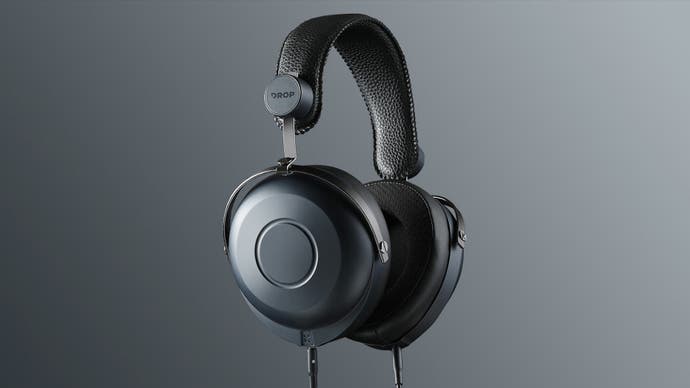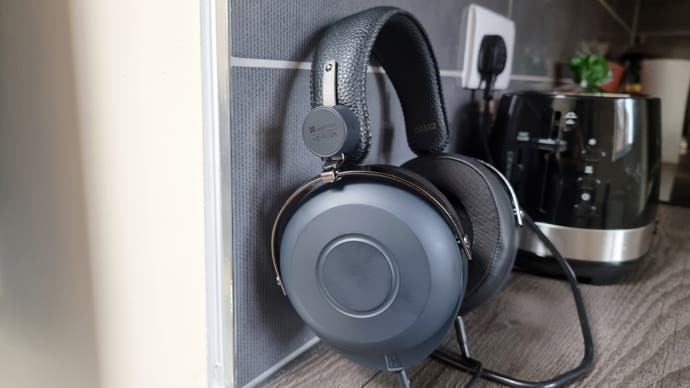Drop + Hifiman HE-R7DX review: these $99 headphones are worth buying
Impressive closed-back headphones for the money.
The pitch for Drop and Hifiman's HE-R7DX headphones is pretty simple: bring the essence of audiophile-grade audio down to an affordable level. At $99, these cans ought to be a solid starter for budding audio enthusiasts, promising great audio even if you're driving them from a standard phone or computer rather than a powerful DAC. In fact, Drop's page promises "excellent isolation, impressive details" and even "open-back-level soundstaging". It sounds like a winning formula, but do the HE-R7DX live up to their billing? We tested the HE-R7DX for two weeks to find out.
The first thing you'll notice getting these headphones out of the box is the design, which is simplistic but somewhat retro, with large navy blue plastic earcups and a black, textured leather headband that’s become Hifiman’s trademark feature, complete with small metal forks connecting the two components together. I’ve seen some complaints that the design is perhaps a little uninspiring, but to me, there’s a certain minimalistic and refined quality to the HE-R7DXs that make them seem a lot more expensive. You won’t find anything in terms of additional controls on the underside of the headphones for controlling volume or the like - that’s all left to the host device - and as these are headphones rather than a headset, there's no mic included either. Connectivity is kept nice and easy with a simple 3.5mm audio jack on the end of what is quite a chunky cable, and in the box, you also get a 3.5mm to 6.35mm adapter to allow use with more professional-grade audio equipment.

Admittedly, these are some of the odder fitting headphones I’ve tested with very little in the way of adjustment apart from on the headband. There’s no real swivel on the earcups, apart from the natural swivel when you put them on your head. The HE-R7DX are also some of the looser fitting cans I’ve used, as they simply rest on your head, as opposed to clamping around your skull. It’s a sensation that takes some getting used to but aids in making these an especially comfortable fit for extended periods of listening. They weigh in at 338g, which is heavier than a lot of the similarly priced gaming headsets I’m used to, but in the headphone world, the HE-R7DXs are quite light, which just aids in making them even more comfortable.
It would be easy to assume that the loose fit would mean they leak noise out, but in actual fact the HE-R7DXs feature pretty good noise isolation even without any music or audio playing. The sound of the rain outside my apartment was somewhat dulled down, as was the noise of construction workers outside; with that being said though, the typing from my Das Keyboard MacTigr wasn’t drowned out unless I turned the cans up to near max volume.
The point of volume leads me nicely onto sound quality. The HE-R7DXs sound, well, rather good indeed. Getting the fit right is key though, as, without it, you won’t get a good enough seal to experience these cans’ powers. They provide Hifiman’s signature neutral sound profile, which means that each part of the frequency response is well-represented and thoughtfully considered. They definitely aren’t bass-heavy monsters, that’s for sure.
Truth be told, the bass here isn’t as impactful as you may initially expect, with a lack of thump about it. That isn’t such a bad thing though, as it allows a little more nuance and texture to seep through and provide more of a rounded low end as opposed to one that feels like you’ve been hit over the head with an axe. A listen to Elvis Costello’s Watching The Detectives exemplified this perfectly, with the low-end tones of Bruce Thomas’ simplistic bassline providing a helpful cushion for the rest of the music to rest on.
The HE-R7DX’s midrange is also well handled, with a smoothness and neutrality to it that makes these sound a fair bit more expensive than they are. They’re a detailed listen too, with plenty of subtle tones extracted in tracks such as a live cut from James Taylor’s stomping Steamroller Blues that I hadn’t ever noticed before. It dealt with vocal-focused tracks such as Helplessly Hoping by Crosby, Stills & Nash wonderfully, with marvellous clarity, as well as with heavier choices such as Rush’s Working Man well, too, with Geddy Lee’s almost shrieking vocal coming across with excellent detail.
When it comes to the top end, these Drop and Hifiman cans excel on their treble presentation, with strings and percussion featuring a sharp but sweet shimmer to them, and a nice overall sparkle. Neil Peart’s cymbal rides in Working Man’s instrumental section didn’t feel harsh or overdone but instead supplement the existing low and mid-range nicely. Steely Dan’s marvellous Do It Again has always been a favourite for testing the top end, and its opening minute of competing percussion elements doesn’t sound as if they’re all on top of each other with the HE-R7DXs. Iinstead, they’re each given their own space to breathe and sound great in the process.
While the entire frequency response range sounds especially nuanced yet balanced with the HE-R7DXs, it’s on the front of its soundstage, or the width of the audio, where things get especially good. For a pair of closed backs, they offer brilliant separation, with different areas of the band given a lot of breathing room, aiding to extract as much out of a song as possible. Closed backs can sometimes sound a little cluttered, with instruments and vocals all mixing together, but with these cans, there’s a sense of depth to the sound that is almost open-back like in quality and presentation. Billy Joel’s Uptown Girl provides a fantastic example, with its opening drum beat carrying a nice reverb to it, as well as the voices of the backing vocalists. In addition, the small bongo noises in the far right corner of a listen of Earth, Wind and Fire’s September sounded as fun and energetic as they should.
All of that combines to make the HE-R7DXs a brilliant all-round pair of headphones to use for working, as much as listening to music and gaming. The fact they don’t sound too harsh or overbearing and offer quite a ‘soft’ profile means they deal with different genres of music equally well, and signal a refinement to their audio that doesn’t seem like it should be on more of an affordable pair of dynamic driver headphones.
In delving into some of the other key technical plus points, the 16-ohm impedance is quite low, meaning you can run these headphones easily even with a smartphone or a computer's integrated audio. To be truthful, I haven’t got a fancy DAC/AMP, and I simply plugged these into the spare 3.5mm jack on my MacBook Pro, and to get such a high quality and balanced sound from something as low power as that must also be a good sign if you wanted to run this on higher end equipment.
All in all, at $99 the Drop and Hifiman HE-R7DXs represent some great value for money when it comes to more audiophile-grade headphones. They offer a gorgeous and refined, almost velvety soft sound profile to them that makes them a marvellous all-rounder for games as much as music, and a brilliant soundstage that a lot of similarly priced closed backs may not be able to compete with. Their fitment will take some getting used to, admittedly, but once it all feels right, you’re sure to have a great time with these cans.









